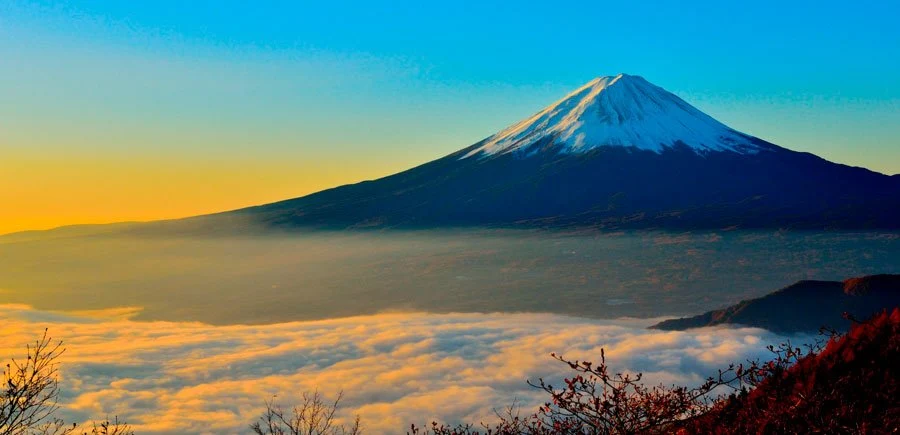The most famous volcano in Japan, better known as Mount Fuji (富士山), is located in Shizuoka Prefecture, on the island of Honshu and about 100 kilometers west of Tokyo. His full Japanese name is Fuji-san, but he is also called Fujisan, Fuji-no-Yama, Fuji-no-Takane, and Huzi, among others. It is a volcano known for the beauty of its landscape and is the symbol of Japan. It has been a recurring theme in traditional Japanese art and identifies the country in the West.
 |
| Mount Fuji Volcano Japan |
The highest peak in the country measures 3,375.6 meters and is classified as an active volcano, that is, it shows signs of continuous volcanic activity or has erupted during the last 10,000 years. Nearby are the Kawaguchi, Yamanaka, Motosu, Shoji, and Sai lakes, and it is also within the Fuji-Hakone-Izu National Park, the most visited in the country.
 |
| Mount Fuji Volcano Japan |
It exhibits a conical shape, if not perfect, quite close to it. Its snowy summit registers a tundra climate, and registers temperatures that range from -38º C to 17.8º C. The cone and its surroundings are habitats of numerous species, and they have a rich variety of birds as well as some 37 species of mammals.
Its summit registers temperatures that range from -38º C to 17.8º C.
 |
| Mount Fuji Volcano Japan |
Training
Mount Fuji is a stratovolcano or composite volcano; It is made up of several layers of rock, ash, and hardened lava. It is located right where three tectonic plates meet: North American, Eurasian, and Philippine, although specifically, it is between the latter and the minor plates of Okhotk and Amuria.
The age of this volcano is estimated at 40,000-10,000 years and is currently on a group of overlapping volcanoes. Before Fuji existed, the Ashitaka, Hakone and Komitake volcanoes were already active, but about 100,000 years ago, the mountain emerged at the foot of the Komitake, which was preceded by the Sen Komitake, the core of this volcano.
After explosive eruptions, 80,000-20,000 years ago a volcano of about 3,000 meters high known as Ko-Fuji (Old Fuji) was created, until 10,000-17,000 years ago a huge lava flow covered it and gradually formed the Shin-Fuji o New Fuji. Mount Fuji or New Fuji, as it is now known, is the product of the volcanic activity of Shin-Fuji, from the solidification of the layers of expelled materials; therefore, below the current one are the ancient volcanoes mentioned.
 |
| Mount Fuji Volcano Japan |
Eruptions
Mount Fuji has not erupted since 1707-1708 but is classified as a low-risk active volcano since it emits fumaroles and shows signs of seismic activity. However, its eruptive history is considerably long: according to the Smithsonian Institution's Global Volcanism Program, 58 confirmed eruptions have been recorded and 9 of uncertain certainty identified.
› 58 confirmed eruptions have been registered since their appearance.
The volcano has been very active since its appearance on the planet. After the formation of the New Fuji a period of inactivity ensued, until some 5,000 years ago it "woke up." Some eruptions have been noted for their intensity or the amount of lava spewed, as occurred in the Jogan period in 864, when a 10-day eruptive event released ash and other materials that reached great distances, resulting in some deaths.
 |
| Mount Fuji Volcano Japan |
The last great eruption dates from 1707, known as "The eruption of Mount Fuji of the Hōei era", because it occurred precisely in that era of Japanese history. It did not throw lava flows, but it did expel 0.8 cubic kilometers of ash, volcanic bombs, and other solid materials that reached Tokyo. The event was preceded by an earthquake that, before the one that occurred in 2011, was considered the most intense in the history of Japan. An eruption from 1708 has yet to be confirmed.
